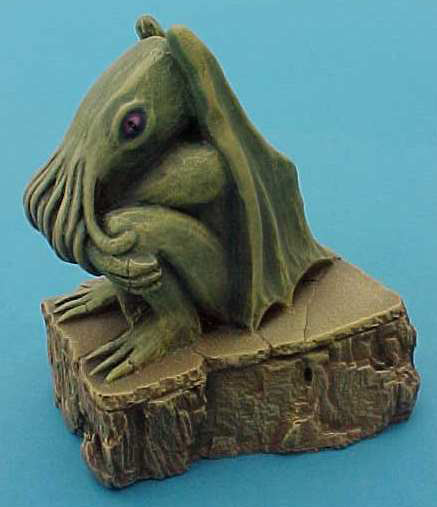View current page
...more recent posts

Calling Cthulhu by Erik Davis:
For [H.P.] Lovecraft, scientific materialism is the ultimate Faustian bargain, not because it hands us Promethean technology (a man for the eighteenth century, Lovecraft had no interest in gadgetry), but because it leads us beyond the horizon of what our minds can withstand. "The most merciful thing in the world, I think, is the inability of the mind to correlate all its contents," goes the famous opening line of "Call of Cthulhu." By correlating those contexts, empiricism opens up "terrifying vistas of reality"—what Lovecraft elsewhere calls "the blind cosmos [that] grinds aimlessly on from nothing to something and from something back to nothing again, neither heeding nor knowing the wishes or existence of the minds that flicker for a second now and then in the darkness."Davis's essay considers the before-and-after role of religion in HPL's prose: elements of magic and ritual appropriated by the author for his world of materialistic horror as well as attempts by various cults and Internet wackos to claim the Necronomicon as an authentic text. The in-depth research illuminates but possibly ameliorates Lovecraft. Davis's emphasis on the "Outside Within," a domain of eldritch visions that can be instructive as well as devastating to the religious seeker, breaks the spell that HPL is indeed describing malevolent conspiracies beyond the control of our Enlightened societies and diminishes his central insight: that these forces are real. (Cue organ.) I prefer the political dimension that some writers have claimed for the Providence recluse, such as Robert Bloch's litany of "modern horrors" not generally cognizable at the time Lovecraft wrote his stories but making him only too relevant to current readers: serial killers operating in the cracks of civilization, technologically assisted genocide, horrors beyond our capacity to absorb horror--to which one might add the televised mass chaos post-Katrina and the drill-killing insanity in Iraq unleashed by Dick Cheney, the ultimate Lovecraftian leader.
Lovecraft gave this existentialist dread an imaginative voice, what he called "cosmic alienage." For Fritz Leiber, the "monstrous nuclear chaos" of Azathoth, Lovecraft's supreme entity, symbolizes "the purposeless, mindless, yet all-powerful universe of materialistic belief." But this symbolism isn't the whole story, for, as DMT voyagers know, hyperspace is haunted. The entities that erupt from Lovecraft's inhuman realms seem to suggest that in a blind mechanistic cosmos, the most alien thing is sentience itself. Peering outward through the cracks of domesticated "human" consciousness, a compassionless materialist like Lovecraft could only react with horror, for reason must cower before the most raw and atavistic dream-dragons of the psyche.
Modern humans usually suppress, ignore or constrain these forces lurking in our lizard brain. Mythically, these forces take the form of demons imprisoned under the angelic yokes of altruism, morality, and intellect. Yet if one does not believe in any ultimate universal purpose, then these primal forces are the most attuned with the cosmos precisely because they are amoral and inhuman. In "The Dunwich Horror," Henry Wheeler overhears a monstrous moan from a diabolical rite and asks "from what unplumbed gulfs of extra-cosmic consciousness or obscure, long-latent heredity, were those half-articular thunder-croakings drawn?" The Outside is within.
[Thanks to Davis for the shout to this blog a while back--I'm disagreeing with him a bit here but his nod made my week--Techgnosis is awesome.]
Photo: Cthulhu (and other carvings against uniformly blue backgrounds) from Monolith Design. "Monolith Design was founded in 1990 by Stephen Mussared and is committed to producing carefully researched, well-made gaming miniatures for a wide variety of scales and periods, from Ancient Egyptian through Twentieth Century to Science Fiction and Fantasy. The models are cast in high quality resin [...]" [via travis about two years ago]


Belatedly posting my tourist photos from the National Museum of the American Indian on the Mall in DC. Forgot to bring the USB cable for my camera when posting from the road--this was almost like getting snapshots from the drugstore after the trip. That's beadwork in the top picture--I love the calmness and focus of the pattern. Below is the sci fi ceiling of the space-hogging but dramatic atrium. The outside is kind of spacy too but it's adobe-oid so it's not too anomalous. One supposes the atrium mimics an igloo but its lines are predominantly modernist. [Friends, family in DC please don't be mad if I didn't reach you--this was a brief stopover on the way down to Charlottesville for my college radio station reunion.]
Update: We're discussing the premises of the museum here.

Juan Cole on Iran war propaganda:
Polling shows that the percentage of Americans who view Iran as the number one threat to the United States has risen to 27 percent now. I think it was only 20 percent in December 2006. First of all, how in the world can a developing country with about a fourth of the population of the US, about a $2000 per capita income (in real terms, not local purchasing power), with no intercontinental ballistic missiles, with no weapons of mass destruction (and no proof positive it is trying to get them), with a small army and a small military budget-- how is such a country a "threat" to the United States of America? Iranian leaders don't like the US, and they talk dirty about the US, and they do attempt to thwart US interests. The same is true of Venezuela under Chavez. But Tehran is a minor player on the world stage, and trying to build it up to replace the Soviet Union is just the worst sort of fear-mongering, and it is being done on behalf of the US military industrial complex, which wants to do to Iran what it did to Iraq. It is propaganda, and significant numbers of Americans (a 7 percent increase would be like 21 million people!) are buying it.Many higher ups in media and the government don't know the difference between Sunni Muslims (comprising most of the Iraq insurgents) and Shiite Muslims (comprising the majority of Iraqis and almost all Iranians). Or that Iranians are Persian, not Arab. How can millions of Americans understand that if it isn't explained to them?
Why have those poll numbers gone up? Because the Bush administration is trying to hang the Sunni Arab insurgency in Iraq on Iran (and even trying to hang the Taliban resurgence in Afghanistan on Iran). The message of administration and military spokesmen is that Iran is deliberately killing US troops and is a major source of insurgency in Iraq. No convincing evidence has ever been presented for either allegation, nor is it reasonable to assume that Iran plays a significant role in funding hyper-Sunni, Shiite-killing death squads to deliberately destabilize its client governments in Baghdad (al-Maliki) and Kabul (Karzai). Yet the New York Times and even the Guardian put this b.s. on the front page, and of course it is all over CNN, Fox Cable News, MSNBC, etc. Are US journalists trapped in the the dictates of the military-industrial complex by virtue of working for these mega corporations? We know that Roger Ailes at Fox Cable News orders his employees how to spin the day's news (he is a former high Republican Party official). Has any of the journalists counted up how many of the 127 US troops killed in Iraq in May was killed in Sunni Arab areas and how many in Shiite neighborhoods? Has any of them actually read the translated communiques on World News Connection of the Sunni Arab guerrillas and what they say about Iran and Shiites? Has any demanded air tight proof and non-anonymous sources before printing this garbage?
No.
Rest in Peace, Steve Gilliard.

The best, most honest, least compromising political blogger, Steve Gilliard, has died. He had a devastating sense of humor and no careerist agenda beyond excellent writing and saying exactly what he thought. Meaning that, unlike DailyKos or MyDD, he didn't use his blog for political activity and he didn't hang with politicians. He also wasn't looking to "move up" to the mainstream media--in fact, he often boasted that his readership was as large as many lefty print mags, so why did he need to join them? And he didn't just vent, he did his homework--for example, a memorable, well-researched series on the history of colonial warfare, from a strategic viewpoint. Reading those case studies helped you to recognize the Iraq War for what it is and also, strangely optimistically, to know that it is a 19th Century relic and therefore doomed (if optimism is the right word for an experiment with such a great human cost). Gilliard remains an inspiration and an ethical yardstick for all attempting to step out of established modes of communication. He will be celebrated long after the Tim Russerts and Peter Beinarts are forgotten jokes of history.
(photo by Lindsay Beyerstein)
